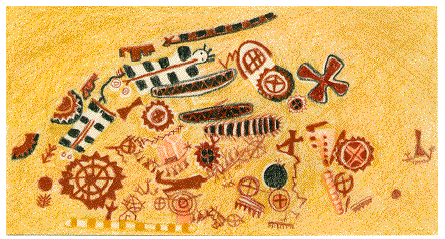PICTOGRAPHS: CHUMASH
|
|
|
Pictographs
from Painted Cave near San Marcos Pass, Santa Barbara County. These rock paintings were probably done by the spiritual leaders, or shamans, of the Chumash. They might have been painted for a ceremony. Some circular designs with rays or spokes look like sun symbols, but the real meanings are not known.
Redrawn image by Sue Ann Sinay, after C. Grant, 1993.
|
PICTOGRAPHS: CHUMASH
ARCHEOLOGICAL EXHIBITS AND MUSEUMS
|
Satwiwa, Santa Monica Mountains National Recreation Area.
Newbury Park, CA
|
San Buenaventura Mission Museum.
Ventura, CA
|
Ventura County Museum of History and Art.
Ventura, CA
|
Santa Barbara Museum of Natural History.
Santa Barbara, CA
|
ROCK ART SITES
|
Chumash Painted Cave State Historic Park.
San Marcos Pass (Highway 154), contact: California Department of Parks and Recreation, Channel Coast District, Santa Barbara, CA
|
Painted Rock, Carrizo Plain.
contact: B.L.M. Bakersfield Field Office, Bakersfield, CA
|
The Chumash people lived in the area that stretched from the Santa Monica Mountains in Los Angeles County to present day San Luis Obispo, and from the ocean to the mountains west of the San Joaquin Valley. They also lived on the northern Channel Islands of Santa Cruz, Santa Rosa, Anacapa, and San Miguel. The Chumash people spoke several different Hokan languages. They have dwelled in this region for at least the past 1,000 years. About 3,000 Chumash people still live in this area.
Some of the coastal villages were quite large. They were usually situated near the mouth of a large stream. These villages served as trading centers for goods from the off shore islands and the interior mountains. There was always a sweat house in the village. It was used for ceremonies and for cleansing the body. An area was set aside as a playground for games. There was also a ceremonial area for dances and religious rituals. A cemetery was located near by. There were areas in the village where tools and artifacts were made. Women used bedrock mortars to process acorns. Food gathering was done in areas that belonged to the village by tradition. Some food gathering areas were distant from the village, and temporary camps would be set up.
Houses were round. They were made of willow poles lashed into a dome shape and covered with thatch. The doorway could be covered with a tule mat, and a hole in the roof ventilated the central fire pit. An extended family, mother, father, children, and grandparents, lived together. Houses were about 12 to 20 feet in diameter.
The village chief's house was the largest. Only the chief could have more than one wife. He used surplus food for entertaining and distributed food to those who were needy. Disputes were usually settled by the chiefs, or occasionally by a ritual battle, or sometimes by burning an enemy village.
The women wore a two-piece soft buckskin skirt with the edges cut into fringes and ornamented with shell beads. A cape was made by folding an oblong piece of animal fur diagonally, and tying the opposite corners together. It was worn covering one arm and shoulder. Earrings and necklaces were made of bone, abalone, and olivella shell. Women wore their hair hung loosely with short bangs and side locks.
The men usually didn't need clothing. In cold weather people wore a large cloak made of rabbit, fox, or sea otter. The chiefs wore a long cloak reaching to their ankles. Men wore a belt or net around the waist to carry knives or other items. The men pierced the septum of their nose and their ears. They used pieces of cane as ornaments, and to carry tobacco. The men's hair was worn very long, tied up with strings, and decorated with bone, flint, and wood.
Redwood or pine plank canoes were used to hunt seals, sea lions, and sea otters as well as to fish in the ocean. Some canoes were up to 30 feet long.
Chumash used strings of olivella shells for money. They traded with the Gabrielino of Santa Catalina Island for steatite, or soap stone. Large pieces of steatite were carved into cooking pots; small pieces were used for effigies, pipes, and beads. The Chumash traded with the Yokuts of the San Joaquin Valley to obtain obsidian for arrow heads and knives. The Mojave traveled from the Colorado River to the Chumash coastal people bringing trade goods such as pottery, woven cotton blankets, and red hematite. The hematite was used for paint.
The rock art paintings of the Chumash are among the most beautiful and complex in the world. They may have depicted mythological beings. They may represent the Shaman's vision of the supernatural world. Some may have been made at the time of the Winter Solstice.
Paints were made from minerals found in rocks. Red paint came from hematite or iron oxide. Orange and yellow paint were made from yellow ocher. Black paint was made from charcoal or a soft black mineral, manganise. White paint came from diatomaceous earth. These minerals were ground and mixed in bowls made of stone, fish vertebrae, or shells. The paint powder was mixed with juice from milkweed, wild cucumber seeds, animal oil, or egg whites. Brushes were made of soap plant, yucca, or animal tails. Symbols were also drawn with lumps of pigment.
Source:
The Chumash People, Materials for Teachers and Students
, Santa Barbara Museum of Natural History, EZ Nature Books, San Luis Obispo, CA 93403, 1991
Go to contents page | Go to previous section | Go to next section
